IPM Module 12 Report: Employee Motivation at Ocean Cleaning Service
VerifiedAdded on 2023/05/08
|21
|5568
|200
Report
AI Summary
This report delves into the critical issue of employee motivation and its impact on labor turnover at Ocean Cleaning Service. It begins with an executive summary and introduction, providing background on the company and the problem of high employee turnover. The report explores the scope of the problem, analyzing the increasing turnover rates over time. A theoretical background is presented, including Maslow's Hierarchy of Needs, Herzberg's Motivator-Hygiene Theory, Theory X and Theory Y, Vroom's Expectancy Theory, and intrinsic/extrinsic motivators. The report examines the causes of staff turnover, its impact on organizational effectiveness, and the influence of perceptions like affective commitment, work engagement, and job satisfaction. Objectives include investigating causes of turnover, determining its impact, and recommending strategies to reduce it. The report concludes with recommendations and a list of team members, aiming to provide actionable insights for improving employee motivation and retention within the organization.
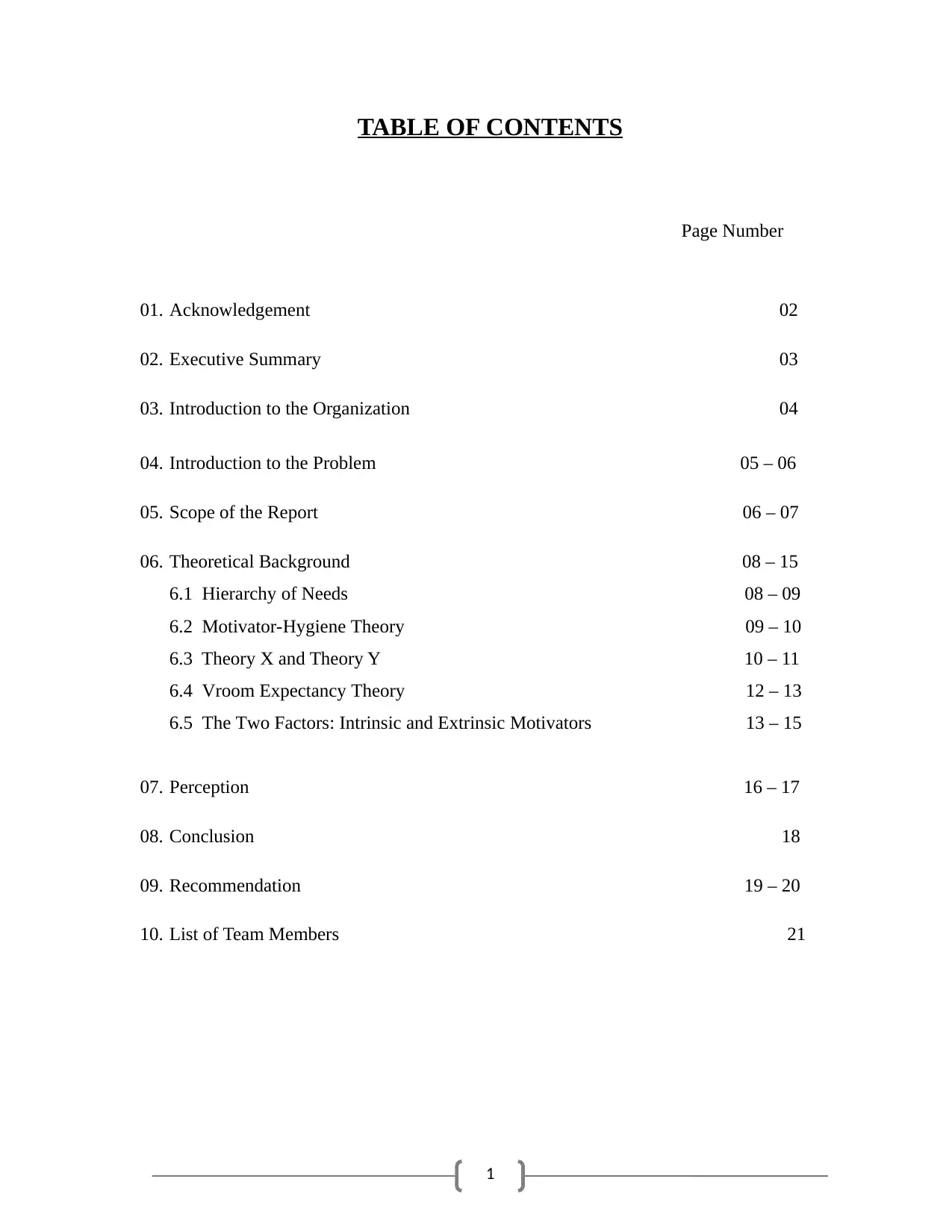
1
TABLE OF CONTENTS
Page Number
01. Acknowledgement 02
02. Executive Summary 03
03. Introduction to the Organization 04
04. Introduction to the Problem 05 – 06
05. Scope of the Report 06 – 07
06. Theoretical Background 08 – 15
6.1 Hierarchy of Needs 08 – 09
6.2 Motivator-Hygiene Theory 09 – 10
6.3 Theory X and Theory Y 10 – 11
6.4 Vroom Expectancy Theory 12 – 13
6.5 The Two Factors: Intrinsic and Extrinsic Motivators 13 – 15
07. Perception 16 – 17
08. Conclusion 18
09. Recommendation 19 – 20
10. List of Team Members 21
TABLE OF CONTENTS
Page Number
01. Acknowledgement 02
02. Executive Summary 03
03. Introduction to the Organization 04
04. Introduction to the Problem 05 – 06
05. Scope of the Report 06 – 07
06. Theoretical Background 08 – 15
6.1 Hierarchy of Needs 08 – 09
6.2 Motivator-Hygiene Theory 09 – 10
6.3 Theory X and Theory Y 10 – 11
6.4 Vroom Expectancy Theory 12 – 13
6.5 The Two Factors: Intrinsic and Extrinsic Motivators 13 – 15
07. Perception 16 – 17
08. Conclusion 18
09. Recommendation 19 – 20
10. List of Team Members 21
Paraphrase This Document
Need a fresh take? Get an instant paraphrase of this document with our AI Paraphraser
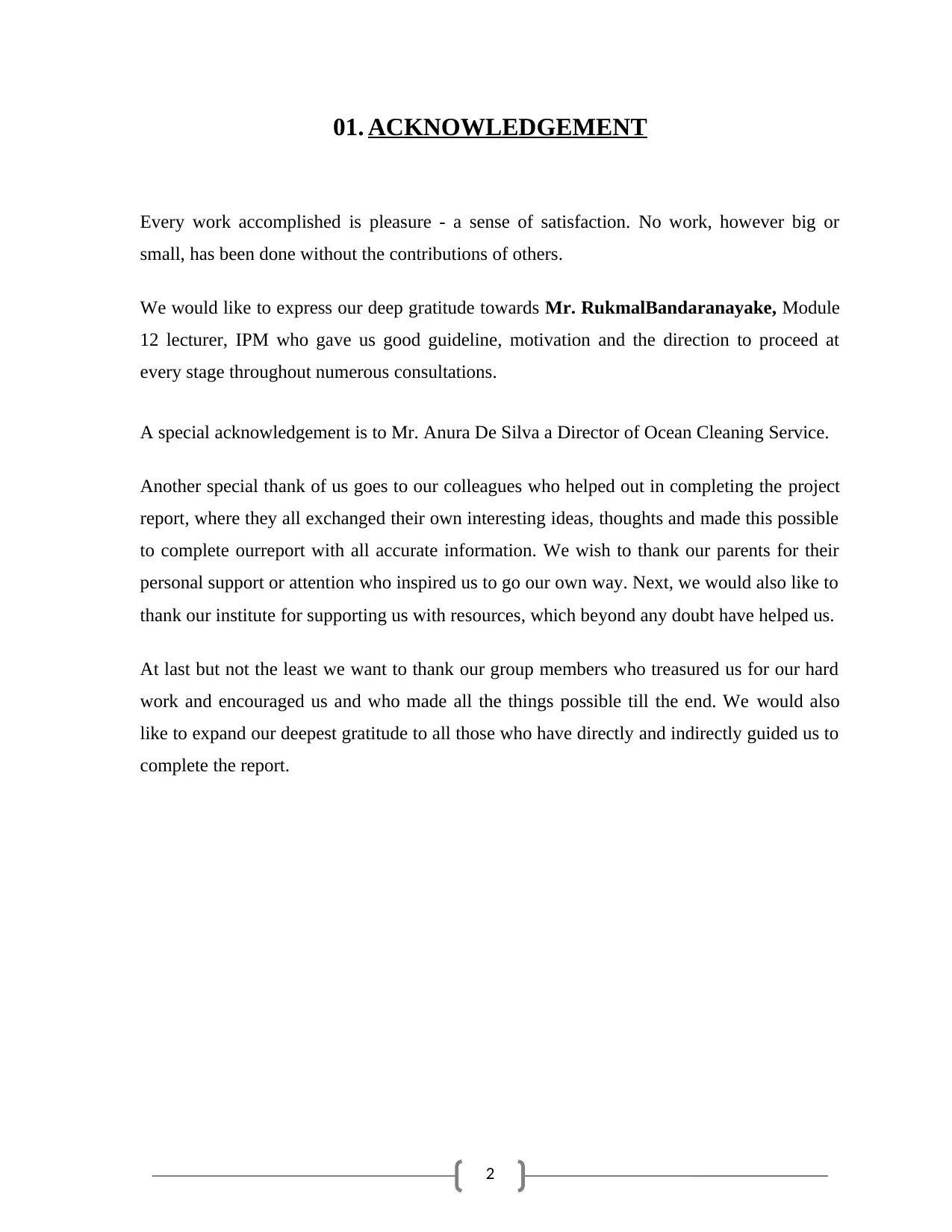
2
01. ACKNOWLEDGEMENT
Every work accomplished is pleasure - a sense of satisfaction. No work, however big or
small, has been done without the contributions of others.
We would like to express our deep gratitude towards Mr. RukmalBandaranayake, Module
12 lecturer, IPM who gave us good guideline, motivation and the direction to proceed at
every stage throughout numerous consultations.
A special acknowledgement is to Mr. Anura De Silva a Director of Ocean Cleaning Service.
Another special thank of us goes to our colleagues who helped out in completing the project
report, where they all exchanged their own interesting ideas, thoughts and made this possible
to complete ourreport with all accurate information. We wish to thank our parents for their
personal support or attention who inspired us to go our own way. Next, we would also like to
thank our institute for supporting us with resources, which beyond any doubt have helped us.
At last but not the least we want to thank our group members who treasured us for our hard
work and encouraged us and who made all the things possible till the end. We would also
like to expand our deepest gratitude to all those who have directly and indirectly guided us to
complete the report.
01. ACKNOWLEDGEMENT
Every work accomplished is pleasure - a sense of satisfaction. No work, however big or
small, has been done without the contributions of others.
We would like to express our deep gratitude towards Mr. RukmalBandaranayake, Module
12 lecturer, IPM who gave us good guideline, motivation and the direction to proceed at
every stage throughout numerous consultations.
A special acknowledgement is to Mr. Anura De Silva a Director of Ocean Cleaning Service.
Another special thank of us goes to our colleagues who helped out in completing the project
report, where they all exchanged their own interesting ideas, thoughts and made this possible
to complete ourreport with all accurate information. We wish to thank our parents for their
personal support or attention who inspired us to go our own way. Next, we would also like to
thank our institute for supporting us with resources, which beyond any doubt have helped us.
At last but not the least we want to thank our group members who treasured us for our hard
work and encouraged us and who made all the things possible till the end. We would also
like to expand our deepest gratitude to all those who have directly and indirectly guided us to
complete the report.
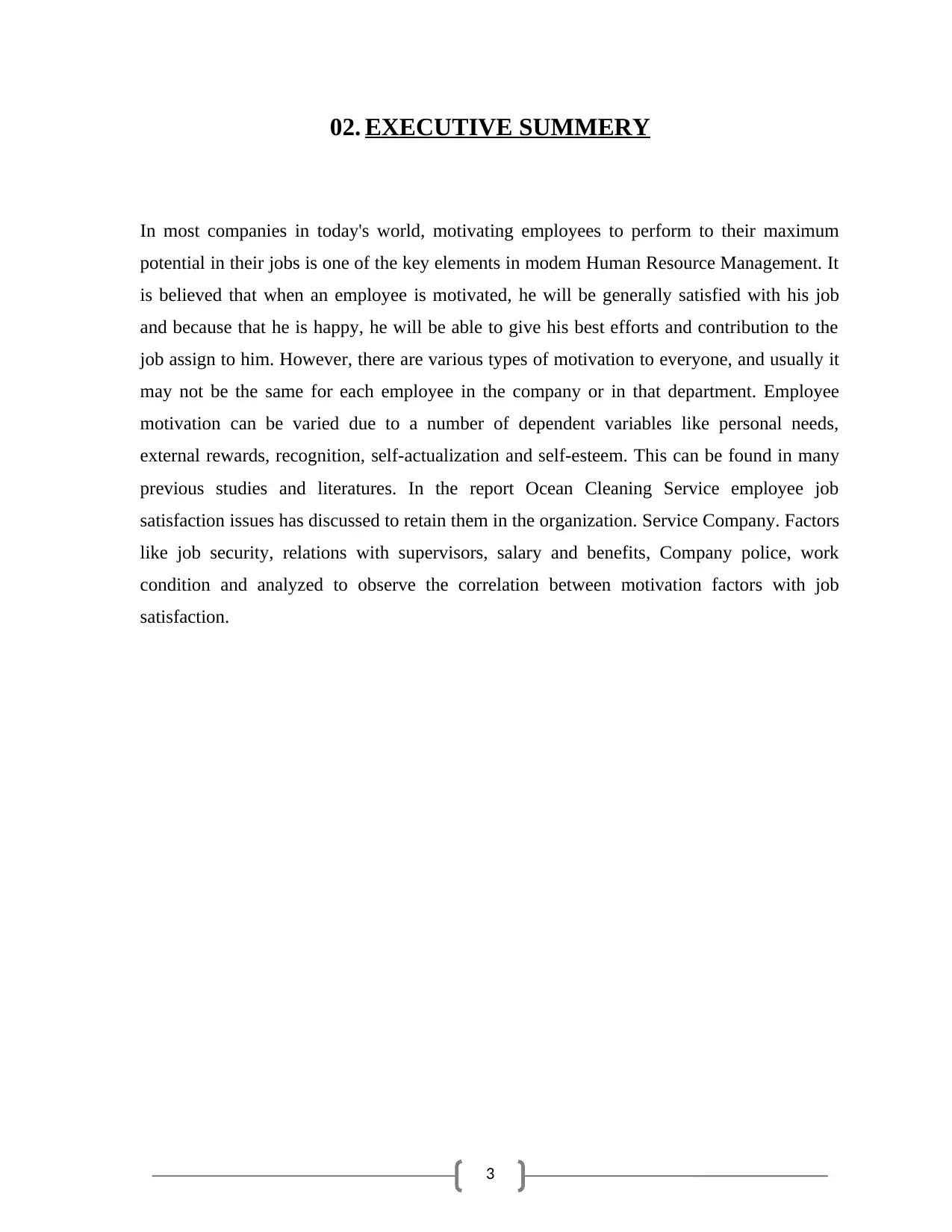
3
02. EXECUTIVE SUMMERY
In most companies in today's world, motivating employees to perform to their maximum
potential in their jobs is one of the key elements in modem Human Resource Management. It
is believed that when an employee is motivated, he will be generally satisfied with his job
and because that he is happy, he will be able to give his best efforts and contribution to the
job assign to him. However, there are various types of motivation to everyone, and usually it
may not be the same for each employee in the company or in that department. Employee
motivation can be varied due to a number of dependent variables like personal needs,
external rewards, recognition, self-actualization and self-esteem. This can be found in many
previous studies and literatures. In the report Ocean Cleaning Service employee job
satisfaction issues has discussed to retain them in the organization. Service Company. Factors
like job security, relations with supervisors, salary and benefits, Company police, work
condition and analyzed to observe the correlation between motivation factors with job
satisfaction.
02. EXECUTIVE SUMMERY
In most companies in today's world, motivating employees to perform to their maximum
potential in their jobs is one of the key elements in modem Human Resource Management. It
is believed that when an employee is motivated, he will be generally satisfied with his job
and because that he is happy, he will be able to give his best efforts and contribution to the
job assign to him. However, there are various types of motivation to everyone, and usually it
may not be the same for each employee in the company or in that department. Employee
motivation can be varied due to a number of dependent variables like personal needs,
external rewards, recognition, self-actualization and self-esteem. This can be found in many
previous studies and literatures. In the report Ocean Cleaning Service employee job
satisfaction issues has discussed to retain them in the organization. Service Company. Factors
like job security, relations with supervisors, salary and benefits, Company police, work
condition and analyzed to observe the correlation between motivation factors with job
satisfaction.
⊘ This is a preview!⊘
Do you want full access?
Subscribe today to unlock all pages.

Trusted by 1+ million students worldwide
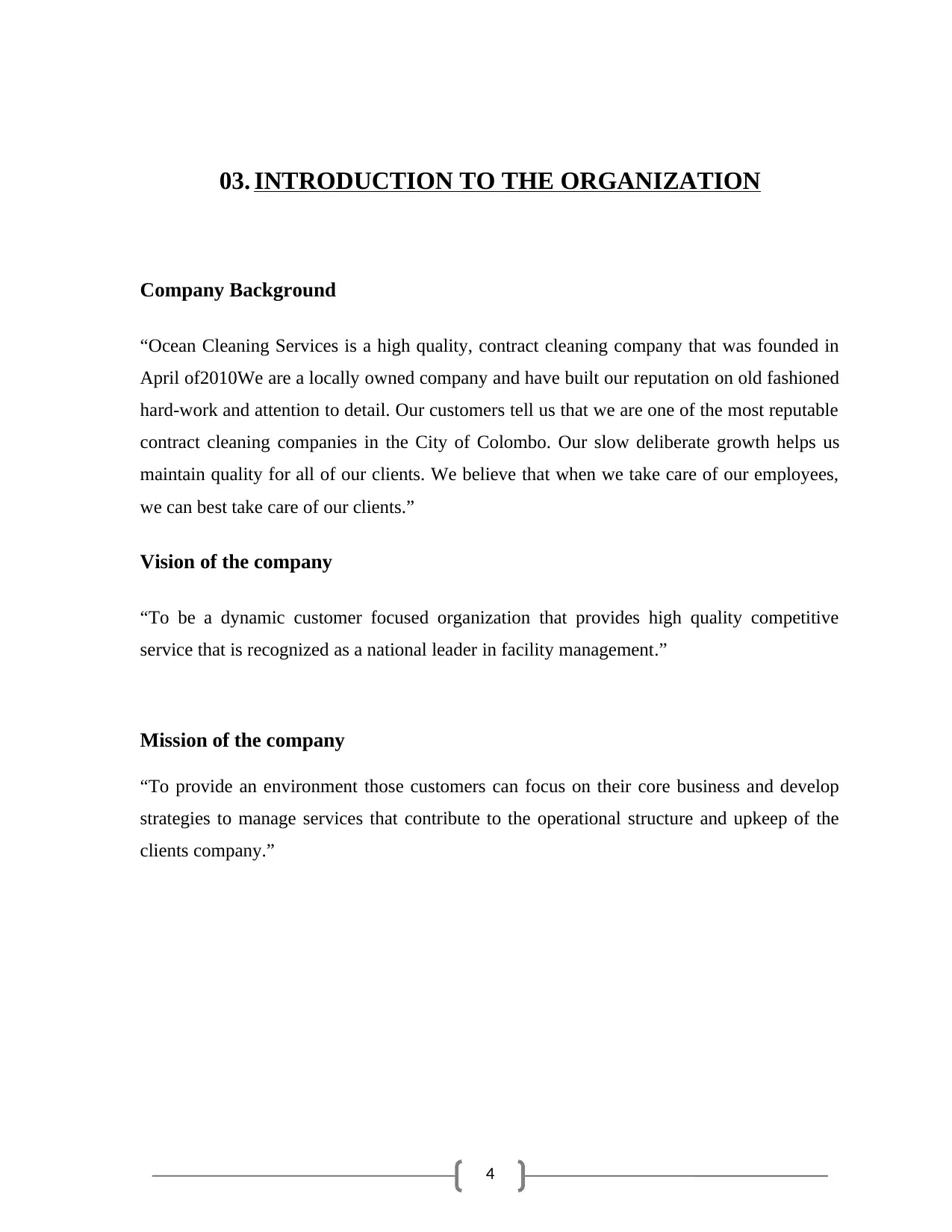
4
03. INTRODUCTION TO THE ORGANIZATION
Company Background
“Ocean Cleaning Services is a high quality, contract cleaning company that was founded in
April of2010We are a locally owned company and have built our reputation on old fashioned
hard-work and attention to detail. Our customers tell us that we are one of the most reputable
contract cleaning companies in the City of Colombo. Our slow deliberate growth helps us
maintain quality for all of our clients. We believe that when we take care of our employees,
we can best take care of our clients.”
Vision of the company
“To be a dynamic customer focused organization that provides high quality competitive
service that is recognized as a national leader in facility management.”
Mission of the company
“To provide an environment those customers can focus on their core business and develop
strategies to manage services that contribute to the operational structure and upkeep of the
clients company.”
03. INTRODUCTION TO THE ORGANIZATION
Company Background
“Ocean Cleaning Services is a high quality, contract cleaning company that was founded in
April of2010We are a locally owned company and have built our reputation on old fashioned
hard-work and attention to detail. Our customers tell us that we are one of the most reputable
contract cleaning companies in the City of Colombo. Our slow deliberate growth helps us
maintain quality for all of our clients. We believe that when we take care of our employees,
we can best take care of our clients.”
Vision of the company
“To be a dynamic customer focused organization that provides high quality competitive
service that is recognized as a national leader in facility management.”
Mission of the company
“To provide an environment those customers can focus on their core business and develop
strategies to manage services that contribute to the operational structure and upkeep of the
clients company.”
Paraphrase This Document
Need a fresh take? Get an instant paraphrase of this document with our AI Paraphraser
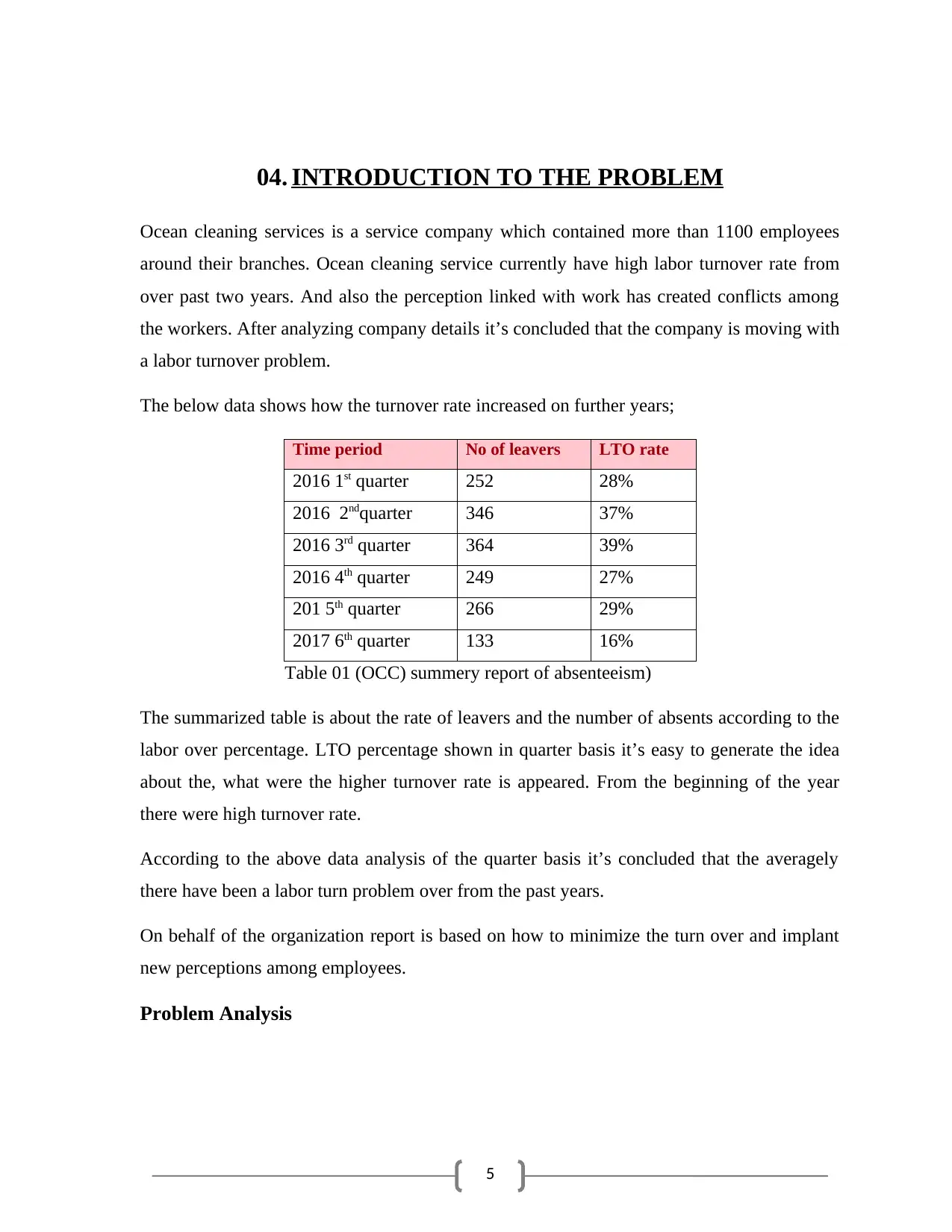
5
04. INTRODUCTION TO THE PROBLEM
Ocean cleaning services is a service company which contained more than 1100 employees
around their branches. Ocean cleaning service currently have high labor turnover rate from
over past two years. And also the perception linked with work has created conflicts among
the workers. After analyzing company details it’s concluded that the company is moving with
a labor turnover problem.
The below data shows how the turnover rate increased on further years;
Time period No of leavers LTO rate
2016 1st quarter 252 28%
2016 2ndquarter 346 37%
2016 3rd quarter 364 39%
2016 4th quarter 249 27%
201 5th quarter 266 29%
2017 6th quarter 133 16%
Table 01 (OCC) summery report of absenteeism)
The summarized table is about the rate of leavers and the number of absents according to the
labor over percentage. LTO percentage shown in quarter basis it’s easy to generate the idea
about the, what were the higher turnover rate is appeared. From the beginning of the year
there were high turnover rate.
According to the above data analysis of the quarter basis it’s concluded that the averagely
there have been a labor turn problem over from the past years.
On behalf of the organization report is based on how to minimize the turn over and implant
new perceptions among employees.
Problem Analysis
04. INTRODUCTION TO THE PROBLEM
Ocean cleaning services is a service company which contained more than 1100 employees
around their branches. Ocean cleaning service currently have high labor turnover rate from
over past two years. And also the perception linked with work has created conflicts among
the workers. After analyzing company details it’s concluded that the company is moving with
a labor turnover problem.
The below data shows how the turnover rate increased on further years;
Time period No of leavers LTO rate
2016 1st quarter 252 28%
2016 2ndquarter 346 37%
2016 3rd quarter 364 39%
2016 4th quarter 249 27%
201 5th quarter 266 29%
2017 6th quarter 133 16%
Table 01 (OCC) summery report of absenteeism)
The summarized table is about the rate of leavers and the number of absents according to the
labor over percentage. LTO percentage shown in quarter basis it’s easy to generate the idea
about the, what were the higher turnover rate is appeared. From the beginning of the year
there were high turnover rate.
According to the above data analysis of the quarter basis it’s concluded that the averagely
there have been a labor turn problem over from the past years.
On behalf of the organization report is based on how to minimize the turn over and implant
new perceptions among employees.
Problem Analysis
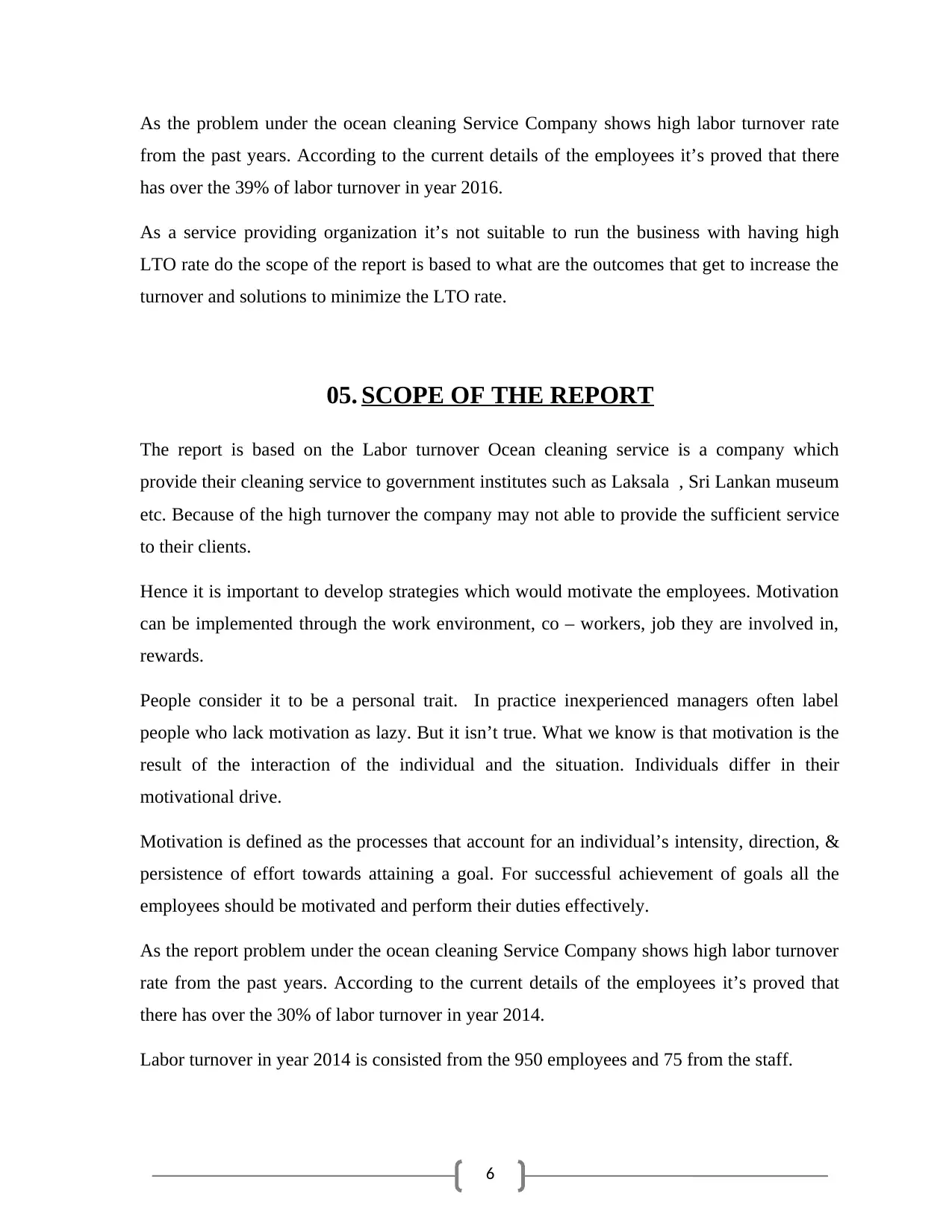
6
As the problem under the ocean cleaning Service Company shows high labor turnover rate
from the past years. According to the current details of the employees it’s proved that there
has over the 39% of labor turnover in year 2016.
As a service providing organization it’s not suitable to run the business with having high
LTO rate do the scope of the report is based to what are the outcomes that get to increase the
turnover and solutions to minimize the LTO rate.
05. SCOPE OF THE REPORT
The report is based on the Labor turnover Ocean cleaning service is a company which
provide their cleaning service to government institutes such as Laksala , Sri Lankan museum
etc. Because of the high turnover the company may not able to provide the sufficient service
to their clients.
Hence it is important to develop strategies which would motivate the employees. Motivation
can be implemented through the work environment, co – workers, job they are involved in,
rewards.
People consider it to be a personal trait. In practice inexperienced managers often label
people who lack motivation as lazy. But it isn’t true. What we know is that motivation is the
result of the interaction of the individual and the situation. Individuals differ in their
motivational drive.
Motivation is defined as the processes that account for an individual’s intensity, direction, &
persistence of effort towards attaining a goal. For successful achievement of goals all the
employees should be motivated and perform their duties effectively.
As the report problem under the ocean cleaning Service Company shows high labor turnover
rate from the past years. According to the current details of the employees it’s proved that
there has over the 30% of labor turnover in year 2014.
Labor turnover in year 2014 is consisted from the 950 employees and 75 from the staff.
As the problem under the ocean cleaning Service Company shows high labor turnover rate
from the past years. According to the current details of the employees it’s proved that there
has over the 39% of labor turnover in year 2016.
As a service providing organization it’s not suitable to run the business with having high
LTO rate do the scope of the report is based to what are the outcomes that get to increase the
turnover and solutions to minimize the LTO rate.
05. SCOPE OF THE REPORT
The report is based on the Labor turnover Ocean cleaning service is a company which
provide their cleaning service to government institutes such as Laksala , Sri Lankan museum
etc. Because of the high turnover the company may not able to provide the sufficient service
to their clients.
Hence it is important to develop strategies which would motivate the employees. Motivation
can be implemented through the work environment, co – workers, job they are involved in,
rewards.
People consider it to be a personal trait. In practice inexperienced managers often label
people who lack motivation as lazy. But it isn’t true. What we know is that motivation is the
result of the interaction of the individual and the situation. Individuals differ in their
motivational drive.
Motivation is defined as the processes that account for an individual’s intensity, direction, &
persistence of effort towards attaining a goal. For successful achievement of goals all the
employees should be motivated and perform their duties effectively.
As the report problem under the ocean cleaning Service Company shows high labor turnover
rate from the past years. According to the current details of the employees it’s proved that
there has over the 30% of labor turnover in year 2014.
Labor turnover in year 2014 is consisted from the 950 employees and 75 from the staff.
⊘ This is a preview!⊘
Do you want full access?
Subscribe today to unlock all pages.

Trusted by 1+ million students worldwide
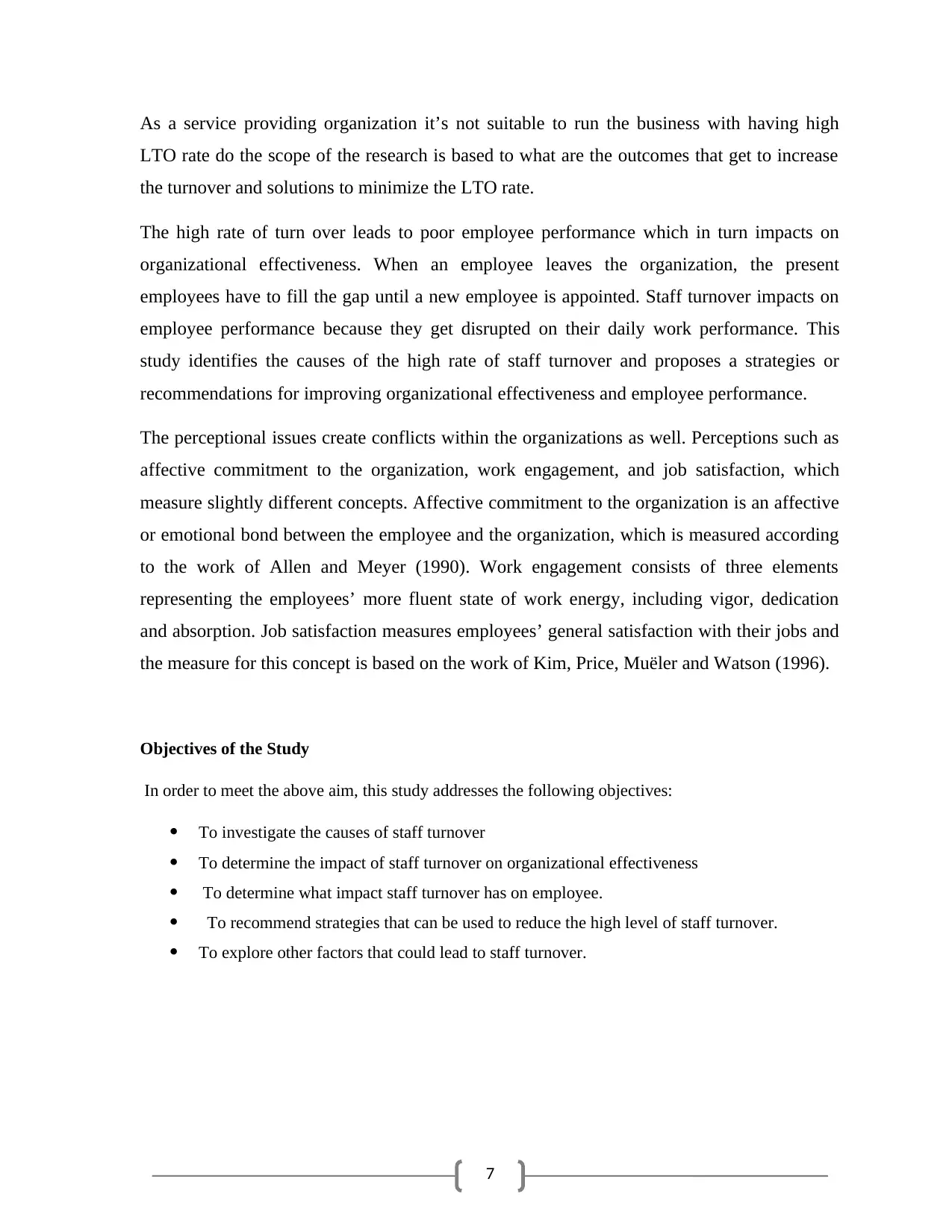
7
As a service providing organization it’s not suitable to run the business with having high
LTO rate do the scope of the research is based to what are the outcomes that get to increase
the turnover and solutions to minimize the LTO rate.
The high rate of turn over leads to poor employee performance which in turn impacts on
organizational effectiveness. When an employee leaves the organization, the present
employees have to fill the gap until a new employee is appointed. Staff turnover impacts on
employee performance because they get disrupted on their daily work performance. This
study identifies the causes of the high rate of staff turnover and proposes a strategies or
recommendations for improving organizational effectiveness and employee performance.
The perceptional issues create conflicts within the organizations as well. Perceptions such as
affective commitment to the organization, work engagement, and job satisfaction, which
measure slightly different concepts. Affective commitment to the organization is an affective
or emotional bond between the employee and the organization, which is measured according
to the work of Allen and Meyer (1990). Work engagement consists of three elements
representing the employees’ more fluent state of work energy, including vigor, dedication
and absorption. Job satisfaction measures employees’ general satisfaction with their jobs and
the measure for this concept is based on the work of Kim, Price, Muëler and Watson (1996).
Objectives of the Study
In order to meet the above aim, this study addresses the following objectives:
To investigate the causes of staff turnover
To determine the impact of staff turnover on organizational effectiveness
To determine what impact staff turnover has on employee.
To recommend strategies that can be used to reduce the high level of staff turnover.
To explore other factors that could lead to staff turnover.
As a service providing organization it’s not suitable to run the business with having high
LTO rate do the scope of the research is based to what are the outcomes that get to increase
the turnover and solutions to minimize the LTO rate.
The high rate of turn over leads to poor employee performance which in turn impacts on
organizational effectiveness. When an employee leaves the organization, the present
employees have to fill the gap until a new employee is appointed. Staff turnover impacts on
employee performance because they get disrupted on their daily work performance. This
study identifies the causes of the high rate of staff turnover and proposes a strategies or
recommendations for improving organizational effectiveness and employee performance.
The perceptional issues create conflicts within the organizations as well. Perceptions such as
affective commitment to the organization, work engagement, and job satisfaction, which
measure slightly different concepts. Affective commitment to the organization is an affective
or emotional bond between the employee and the organization, which is measured according
to the work of Allen and Meyer (1990). Work engagement consists of three elements
representing the employees’ more fluent state of work energy, including vigor, dedication
and absorption. Job satisfaction measures employees’ general satisfaction with their jobs and
the measure for this concept is based on the work of Kim, Price, Muëler and Watson (1996).
Objectives of the Study
In order to meet the above aim, this study addresses the following objectives:
To investigate the causes of staff turnover
To determine the impact of staff turnover on organizational effectiveness
To determine what impact staff turnover has on employee.
To recommend strategies that can be used to reduce the high level of staff turnover.
To explore other factors that could lead to staff turnover.
Paraphrase This Document
Need a fresh take? Get an instant paraphrase of this document with our AI Paraphraser
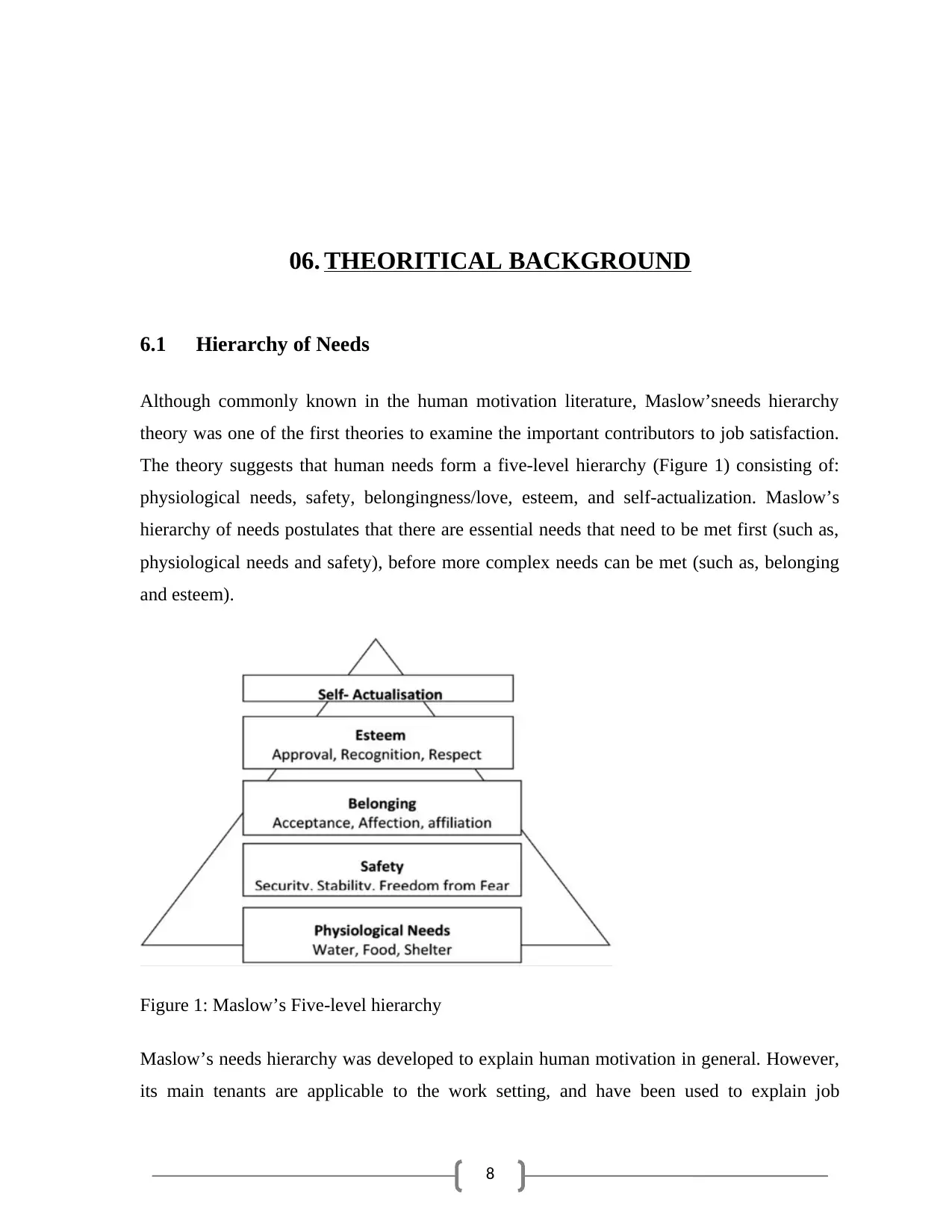
8
06. THEORITICAL BACKGROUND
6.1 Hierarchy of Needs
Although commonly known in the human motivation literature, Maslow’sneeds hierarchy
theory was one of the first theories to examine the important contributors to job satisfaction.
The theory suggests that human needs form a five-level hierarchy (Figure 1) consisting of:
physiological needs, safety, belongingness/love, esteem, and self-actualization. Maslow’s
hierarchy of needs postulates that there are essential needs that need to be met first (such as,
physiological needs and safety), before more complex needs can be met (such as, belonging
and esteem).
Figure 1: Maslow’s Five-level hierarchy
Maslow’s needs hierarchy was developed to explain human motivation in general. However,
its main tenants are applicable to the work setting, and have been used to explain job
06. THEORITICAL BACKGROUND
6.1 Hierarchy of Needs
Although commonly known in the human motivation literature, Maslow’sneeds hierarchy
theory was one of the first theories to examine the important contributors to job satisfaction.
The theory suggests that human needs form a five-level hierarchy (Figure 1) consisting of:
physiological needs, safety, belongingness/love, esteem, and self-actualization. Maslow’s
hierarchy of needs postulates that there are essential needs that need to be met first (such as,
physiological needs and safety), before more complex needs can be met (such as, belonging
and esteem).
Figure 1: Maslow’s Five-level hierarchy
Maslow’s needs hierarchy was developed to explain human motivation in general. However,
its main tenants are applicable to the work setting, and have been used to explain job
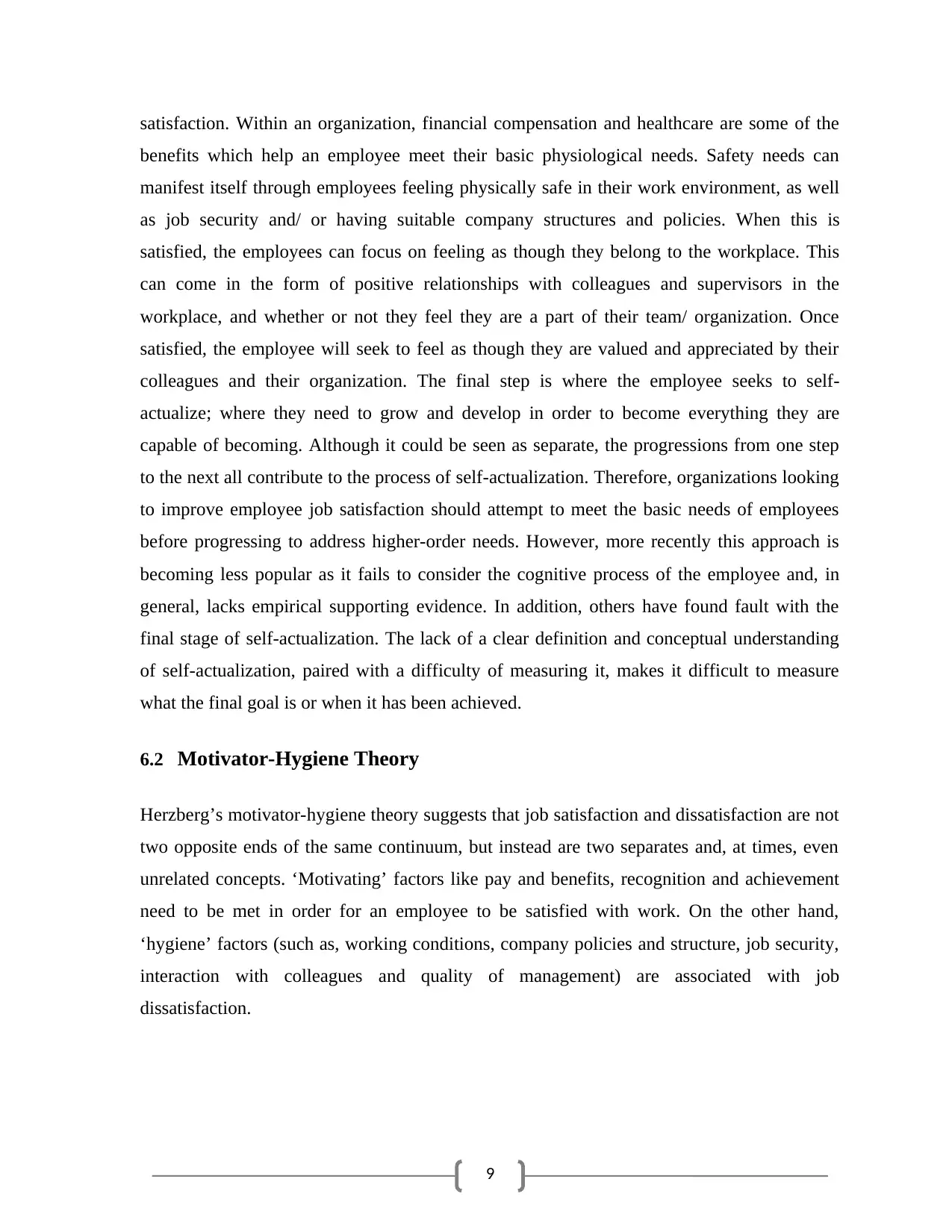
9
satisfaction. Within an organization, financial compensation and healthcare are some of the
benefits which help an employee meet their basic physiological needs. Safety needs can
manifest itself through employees feeling physically safe in their work environment, as well
as job security and/ or having suitable company structures and policies. When this is
satisfied, the employees can focus on feeling as though they belong to the workplace. This
can come in the form of positive relationships with colleagues and supervisors in the
workplace, and whether or not they feel they are a part of their team/ organization. Once
satisfied, the employee will seek to feel as though they are valued and appreciated by their
colleagues and their organization. The final step is where the employee seeks to self-
actualize; where they need to grow and develop in order to become everything they are
capable of becoming. Although it could be seen as separate, the progressions from one step
to the next all contribute to the process of self-actualization. Therefore, organizations looking
to improve employee job satisfaction should attempt to meet the basic needs of employees
before progressing to address higher-order needs. However, more recently this approach is
becoming less popular as it fails to consider the cognitive process of the employee and, in
general, lacks empirical supporting evidence. In addition, others have found fault with the
final stage of self-actualization. The lack of a clear definition and conceptual understanding
of self-actualization, paired with a difficulty of measuring it, makes it difficult to measure
what the final goal is or when it has been achieved.
6.2 Motivator-Hygiene Theory
Herzberg’s motivator-hygiene theory suggests that job satisfaction and dissatisfaction are not
two opposite ends of the same continuum, but instead are two separates and, at times, even
unrelated concepts. ‘Motivating’ factors like pay and benefits, recognition and achievement
need to be met in order for an employee to be satisfied with work. On the other hand,
‘hygiene’ factors (such as, working conditions, company policies and structure, job security,
interaction with colleagues and quality of management) are associated with job
dissatisfaction.
satisfaction. Within an organization, financial compensation and healthcare are some of the
benefits which help an employee meet their basic physiological needs. Safety needs can
manifest itself through employees feeling physically safe in their work environment, as well
as job security and/ or having suitable company structures and policies. When this is
satisfied, the employees can focus on feeling as though they belong to the workplace. This
can come in the form of positive relationships with colleagues and supervisors in the
workplace, and whether or not they feel they are a part of their team/ organization. Once
satisfied, the employee will seek to feel as though they are valued and appreciated by their
colleagues and their organization. The final step is where the employee seeks to self-
actualize; where they need to grow and develop in order to become everything they are
capable of becoming. Although it could be seen as separate, the progressions from one step
to the next all contribute to the process of self-actualization. Therefore, organizations looking
to improve employee job satisfaction should attempt to meet the basic needs of employees
before progressing to address higher-order needs. However, more recently this approach is
becoming less popular as it fails to consider the cognitive process of the employee and, in
general, lacks empirical supporting evidence. In addition, others have found fault with the
final stage of self-actualization. The lack of a clear definition and conceptual understanding
of self-actualization, paired with a difficulty of measuring it, makes it difficult to measure
what the final goal is or when it has been achieved.
6.2 Motivator-Hygiene Theory
Herzberg’s motivator-hygiene theory suggests that job satisfaction and dissatisfaction are not
two opposite ends of the same continuum, but instead are two separates and, at times, even
unrelated concepts. ‘Motivating’ factors like pay and benefits, recognition and achievement
need to be met in order for an employee to be satisfied with work. On the other hand,
‘hygiene’ factors (such as, working conditions, company policies and structure, job security,
interaction with colleagues and quality of management) are associated with job
dissatisfaction.
⊘ This is a preview!⊘
Do you want full access?
Subscribe today to unlock all pages.

Trusted by 1+ million students worldwide
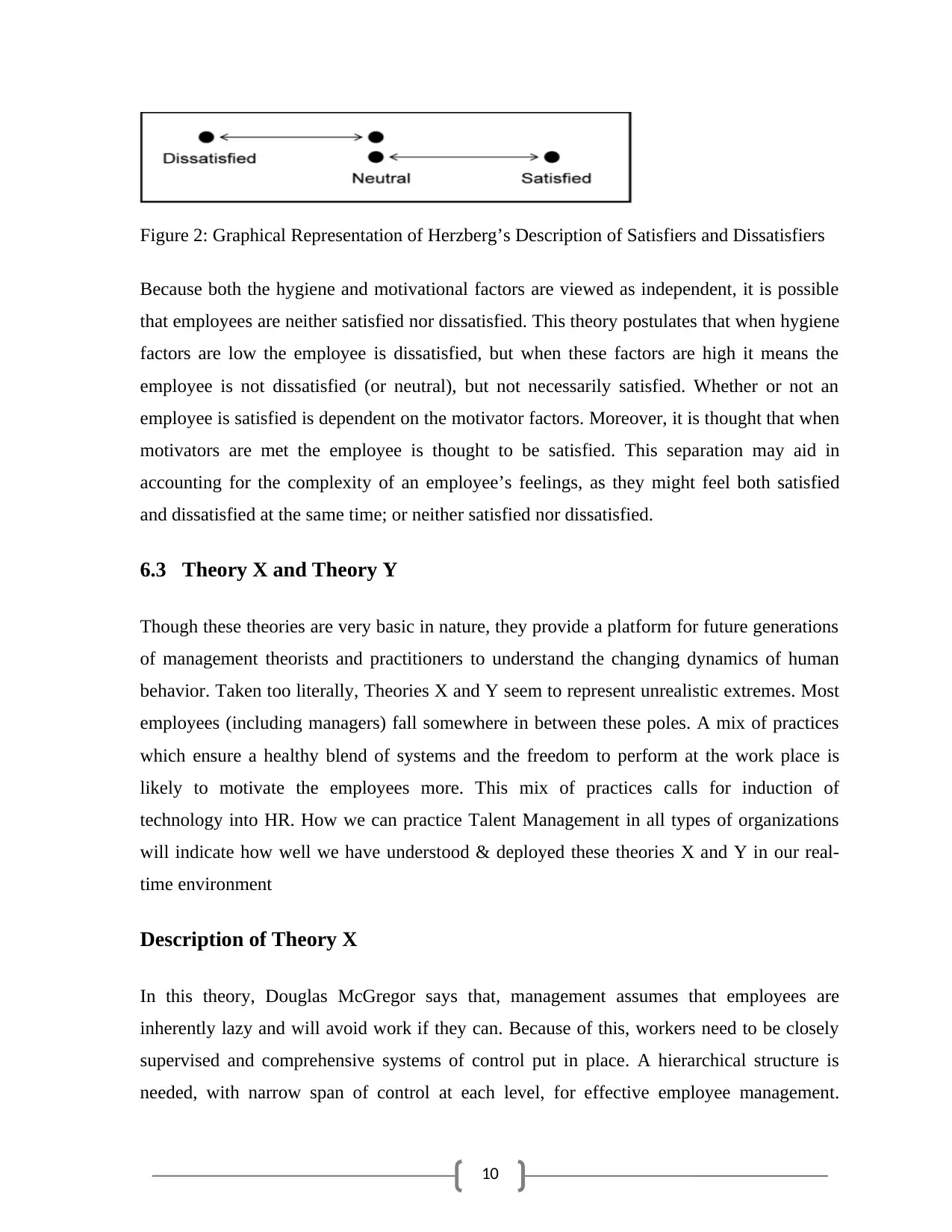
10
Figure 2: Graphical Representation of Herzberg’s Description of Satisfiers and Dissatisfiers
Because both the hygiene and motivational factors are viewed as independent, it is possible
that employees are neither satisfied nor dissatisfied. This theory postulates that when hygiene
factors are low the employee is dissatisfied, but when these factors are high it means the
employee is not dissatisfied (or neutral), but not necessarily satisfied. Whether or not an
employee is satisfied is dependent on the motivator factors. Moreover, it is thought that when
motivators are met the employee is thought to be satisfied. This separation may aid in
accounting for the complexity of an employee’s feelings, as they might feel both satisfied
and dissatisfied at the same time; or neither satisfied nor dissatisfied.
6.3 Theory X and Theory Y
Though these theories are very basic in nature, they provide a platform for future generations
of management theorists and practitioners to understand the changing dynamics of human
behavior. Taken too literally, Theories X and Y seem to represent unrealistic extremes. Most
employees (including managers) fall somewhere in between these poles. A mix of practices
which ensure a healthy blend of systems and the freedom to perform at the work place is
likely to motivate the employees more. This mix of practices calls for induction of
technology into HR. How we can practice Talent Management in all types of organizations
will indicate how well we have understood & deployed these theories X and Y in our real-
time environment
Description of Theory X
In this theory, Douglas McGregor says that, management assumes that employees are
inherently lazy and will avoid work if they can. Because of this, workers need to be closely
supervised and comprehensive systems of control put in place. A hierarchical structure is
needed, with narrow span of control at each level, for effective employee management.
Figure 2: Graphical Representation of Herzberg’s Description of Satisfiers and Dissatisfiers
Because both the hygiene and motivational factors are viewed as independent, it is possible
that employees are neither satisfied nor dissatisfied. This theory postulates that when hygiene
factors are low the employee is dissatisfied, but when these factors are high it means the
employee is not dissatisfied (or neutral), but not necessarily satisfied. Whether or not an
employee is satisfied is dependent on the motivator factors. Moreover, it is thought that when
motivators are met the employee is thought to be satisfied. This separation may aid in
accounting for the complexity of an employee’s feelings, as they might feel both satisfied
and dissatisfied at the same time; or neither satisfied nor dissatisfied.
6.3 Theory X and Theory Y
Though these theories are very basic in nature, they provide a platform for future generations
of management theorists and practitioners to understand the changing dynamics of human
behavior. Taken too literally, Theories X and Y seem to represent unrealistic extremes. Most
employees (including managers) fall somewhere in between these poles. A mix of practices
which ensure a healthy blend of systems and the freedom to perform at the work place is
likely to motivate the employees more. This mix of practices calls for induction of
technology into HR. How we can practice Talent Management in all types of organizations
will indicate how well we have understood & deployed these theories X and Y in our real-
time environment
Description of Theory X
In this theory, Douglas McGregor says that, management assumes that employees are
inherently lazy and will avoid work if they can. Because of this, workers need to be closely
supervised and comprehensive systems of control put in place. A hierarchical structure is
needed, with narrow span of control at each level, for effective employee management.
Paraphrase This Document
Need a fresh take? Get an instant paraphrase of this document with our AI Paraphraser
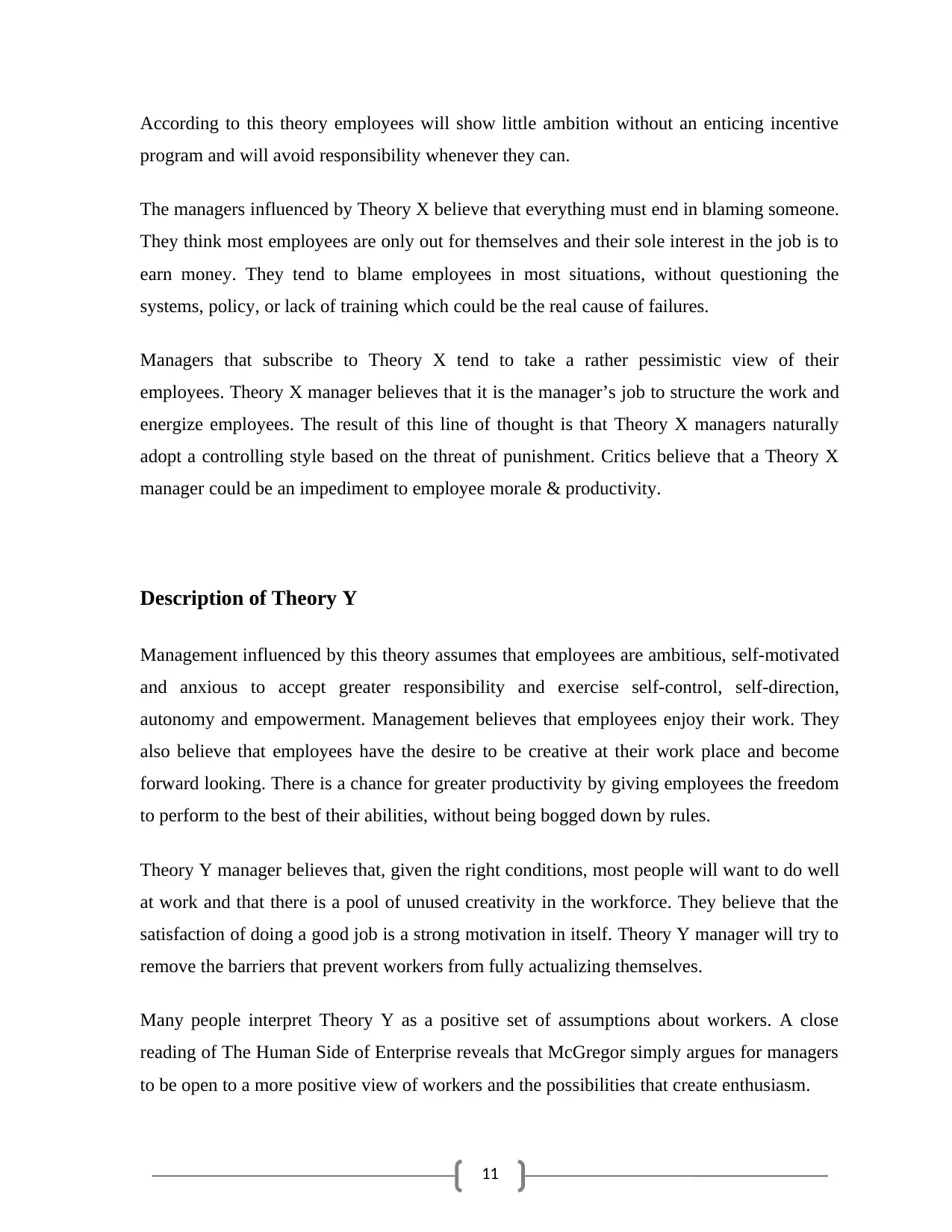
11
According to this theory employees will show little ambition without an enticing incentive
program and will avoid responsibility whenever they can.
The managers influenced by Theory X believe that everything must end in blaming someone.
They think most employees are only out for themselves and their sole interest in the job is to
earn money. They tend to blame employees in most situations, without questioning the
systems, policy, or lack of training which could be the real cause of failures.
Managers that subscribe to Theory X tend to take a rather pessimistic view of their
employees. Theory X manager believes that it is the manager’s job to structure the work and
energize employees. The result of this line of thought is that Theory X managers naturally
adopt a controlling style based on the threat of punishment. Critics believe that a Theory X
manager could be an impediment to employee morale & productivity.
Description of Theory Y
Management influenced by this theory assumes that employees are ambitious, self-motivated
and anxious to accept greater responsibility and exercise self-control, self-direction,
autonomy and empowerment. Management believes that employees enjoy their work. They
also believe that employees have the desire to be creative at their work place and become
forward looking. There is a chance for greater productivity by giving employees the freedom
to perform to the best of their abilities, without being bogged down by rules.
Theory Y manager believes that, given the right conditions, most people will want to do well
at work and that there is a pool of unused creativity in the workforce. They believe that the
satisfaction of doing a good job is a strong motivation in itself. Theory Y manager will try to
remove the barriers that prevent workers from fully actualizing themselves.
Many people interpret Theory Y as a positive set of assumptions about workers. A close
reading of The Human Side of Enterprise reveals that McGregor simply argues for managers
to be open to a more positive view of workers and the possibilities that create enthusiasm.
According to this theory employees will show little ambition without an enticing incentive
program and will avoid responsibility whenever they can.
The managers influenced by Theory X believe that everything must end in blaming someone.
They think most employees are only out for themselves and their sole interest in the job is to
earn money. They tend to blame employees in most situations, without questioning the
systems, policy, or lack of training which could be the real cause of failures.
Managers that subscribe to Theory X tend to take a rather pessimistic view of their
employees. Theory X manager believes that it is the manager’s job to structure the work and
energize employees. The result of this line of thought is that Theory X managers naturally
adopt a controlling style based on the threat of punishment. Critics believe that a Theory X
manager could be an impediment to employee morale & productivity.
Description of Theory Y
Management influenced by this theory assumes that employees are ambitious, self-motivated
and anxious to accept greater responsibility and exercise self-control, self-direction,
autonomy and empowerment. Management believes that employees enjoy their work. They
also believe that employees have the desire to be creative at their work place and become
forward looking. There is a chance for greater productivity by giving employees the freedom
to perform to the best of their abilities, without being bogged down by rules.
Theory Y manager believes that, given the right conditions, most people will want to do well
at work and that there is a pool of unused creativity in the workforce. They believe that the
satisfaction of doing a good job is a strong motivation in itself. Theory Y manager will try to
remove the barriers that prevent workers from fully actualizing themselves.
Many people interpret Theory Y as a positive set of assumptions about workers. A close
reading of The Human Side of Enterprise reveals that McGregor simply argues for managers
to be open to a more positive view of workers and the possibilities that create enthusiasm.
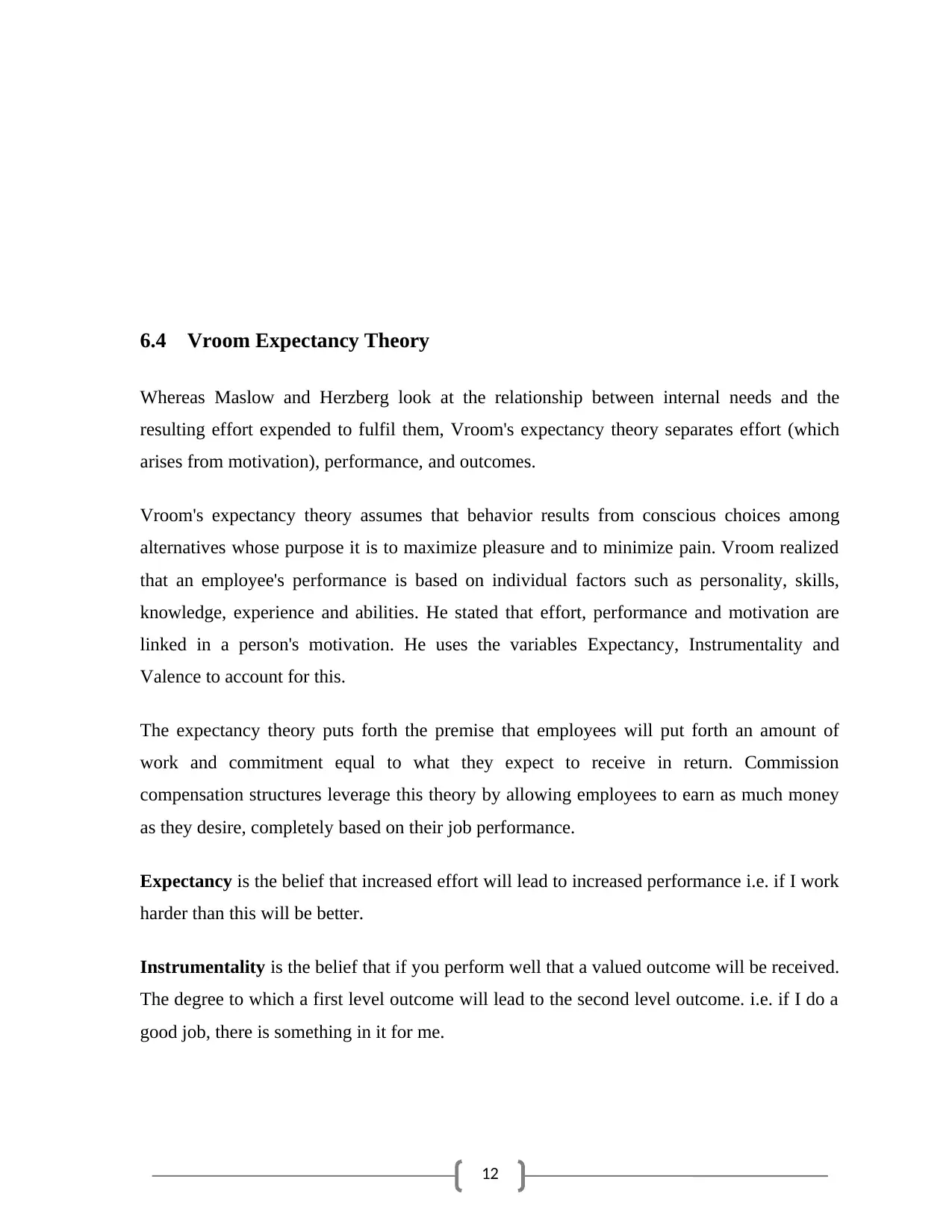
12
6.4 Vroom Expectancy Theory
Whereas Maslow and Herzberg look at the relationship between internal needs and the
resulting effort expended to fulfil them, Vroom's expectancy theory separates effort (which
arises from motivation), performance, and outcomes.
Vroom's expectancy theory assumes that behavior results from conscious choices among
alternatives whose purpose it is to maximize pleasure and to minimize pain. Vroom realized
that an employee's performance is based on individual factors such as personality, skills,
knowledge, experience and abilities. He stated that effort, performance and motivation are
linked in a person's motivation. He uses the variables Expectancy, Instrumentality and
Valence to account for this.
The expectancy theory puts forth the premise that employees will put forth an amount of
work and commitment equal to what they expect to receive in return. Commission
compensation structures leverage this theory by allowing employees to earn as much money
as they desire, completely based on their job performance.
Expectancy is the belief that increased effort will lead to increased performance i.e. if I work
harder than this will be better.
Instrumentality is the belief that if you perform well that a valued outcome will be received.
The degree to which a first level outcome will lead to the second level outcome. i.e. if I do a
good job, there is something in it for me.
6.4 Vroom Expectancy Theory
Whereas Maslow and Herzberg look at the relationship between internal needs and the
resulting effort expended to fulfil them, Vroom's expectancy theory separates effort (which
arises from motivation), performance, and outcomes.
Vroom's expectancy theory assumes that behavior results from conscious choices among
alternatives whose purpose it is to maximize pleasure and to minimize pain. Vroom realized
that an employee's performance is based on individual factors such as personality, skills,
knowledge, experience and abilities. He stated that effort, performance and motivation are
linked in a person's motivation. He uses the variables Expectancy, Instrumentality and
Valence to account for this.
The expectancy theory puts forth the premise that employees will put forth an amount of
work and commitment equal to what they expect to receive in return. Commission
compensation structures leverage this theory by allowing employees to earn as much money
as they desire, completely based on their job performance.
Expectancy is the belief that increased effort will lead to increased performance i.e. if I work
harder than this will be better.
Instrumentality is the belief that if you perform well that a valued outcome will be received.
The degree to which a first level outcome will lead to the second level outcome. i.e. if I do a
good job, there is something in it for me.
⊘ This is a preview!⊘
Do you want full access?
Subscribe today to unlock all pages.

Trusted by 1+ million students worldwide
1 out of 21
Related Documents
Your All-in-One AI-Powered Toolkit for Academic Success.
+13062052269
info@desklib.com
Available 24*7 on WhatsApp / Email
![[object Object]](/_next/static/media/star-bottom.7253800d.svg)
Unlock your academic potential
Copyright © 2020–2025 A2Z Services. All Rights Reserved. Developed and managed by ZUCOL.





